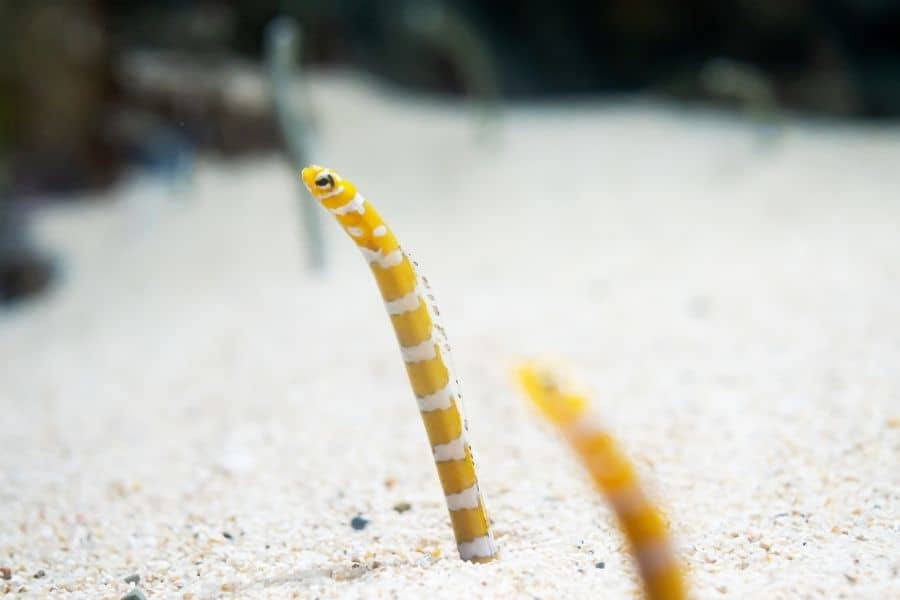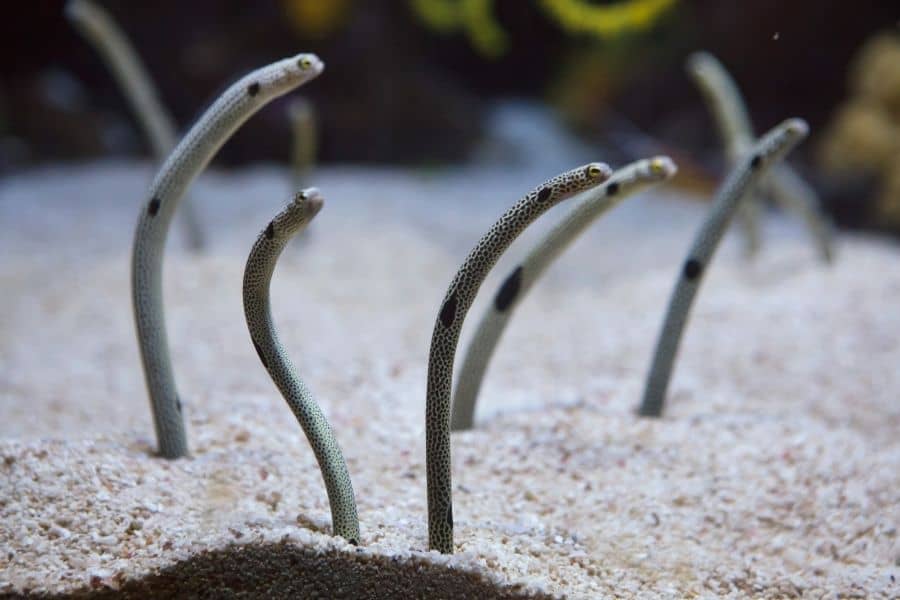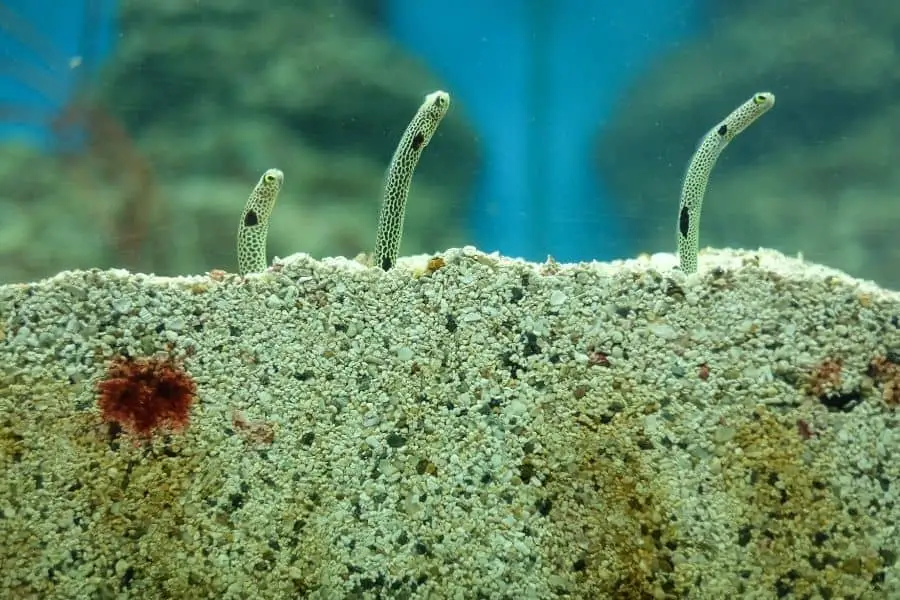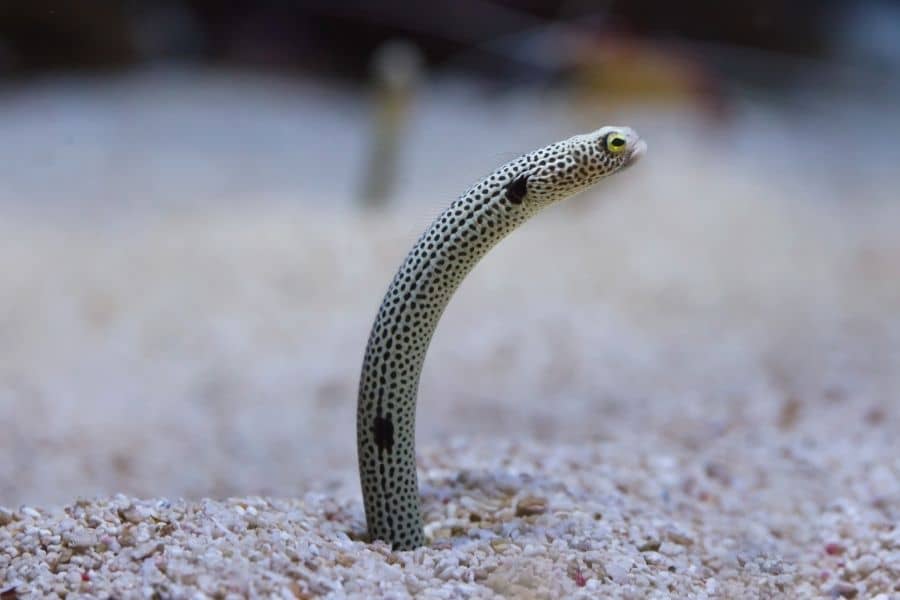Garden eel is a small marine creatures who live inside burrows on sandy bases exposed to water currents at depths of 15 – 45 meters. They are an exciting species that can be kept in saltwater aquariums.
However, they need special care, including a special aquarium setup, food, and water conditions. Because of this reason, Garden Eels are considered hard to care fish that need expert-level experience.
In this article, I’ll answer all your questions regarding Garden Eel. Hopefully by the end of the article, you’ll feel confident adding them to your collocation.
What Is Garden Eel & Appearance
Jump To
- 1 What Is Garden Eel & Appearance
- 2 Garden Eels Habitats
- 3 How Big Do Garden Eels Get?
- 4 Behavior
- 5 Garden Eel Lifespan
- 6 ONE LOOK CARE GUIDE
- 7 Garden Eel Care In Reef Tank Or Aquariums
- 8 Garden Eel Breeding
- 9 How To Feed Garden Eel?
- 10 What Fish Can Live With Garden Eel In Aquarium? Garden Eel Tank Mates
- 11 Will Garden Eels Eat Cleaner Shrimp?
- 12 Garden Eel Predators
- 13 Garden Eel Facts
- 14 Types Of Garden Eel
- 15 Related Questions
- 16 Source

Garden Eel is a set of fish species (35 species) named under the Heterocongrinae subfamily, in the conger eel family Congridae.
They tend to live in groups and grows up to 47 inches in length. Among these eels, the one species that aquarium owners tend to keep is the Spotted Garden Eel(Heteroconger hassi).
This Spotted Garden eel, also known as Hass’s Garden Eel, is a small fish that reaches about 16 inches and has small black spots in the white-colored body.
It has three large distinctive black spots; the first one surrounds the gill opening and pectoral fin, the second one in the central part of the body, and the last one surrounds the anus.
Juvenile Spotted Garden Eels are entirely black. The Spotted Garden Eel can be found in the Indo-Pacific Ocean, specifically in East Africa, north to Japan, south to New Caledonia, and east to the Pitcairn Islands.
Garden Eels Habitats

Garden Eels are marine fish that lives majorly in the Indo-Pacific Ocean. But, some species of Garden Eels are found in warmer parts of the Atlantic Ocean (including the Caribbean) and East Pacific Ocean.
How Big Do Garden Eels Get?
A garden eel can grows up to 47 inches long; however, the spotted Garden Eel grows up to 16 inches long. The Garden Eel that we keep in aquariums is Spotted Garden Eel.
Behavior
Garden Eels are under-substrate living fish species, so they don’t have the usual behavior of other bottom-living or free-swimming fish. Their habitat needs are different so is their behavior.
Behaviour Of Garden Eel
Garden Eels lives in the sand, digging a burrow, and lives inside. They expose up to two-thirds of its body outside the burrow to find food.
They point their mouths towards the underwater current to catch drifting food. After feeding, they go inside the burrow again.
During the breeding season, the Eels tend to move their burrow to another place until they find a breeding partner.
They mate, stretching over from the burrows and entwining their bodies, but never leave their burrows.
While they are outside the burrow for finding food or breeding, they immediately go back to the burrow if they get disturbed or feel threatened.
Can You Have Garden Eels As Pets?
You can have Garden Eels as pets if you are a well-experienced fish keeper, especially with saltwater fish.
Garden Eels are considered expert-only fish because their needs are different from other fish types. Other than that, you can have Garden Eels as pets.
Is Garden Eel Aggressive?
Garden Eels are peaceful fish species that can live with other non-aggressive fish species. However, they become aggressive in the mating season and fight with their own species as a course of mate competition.
They also fight when in too close proximity to one another. However, these fights last a short period, and they do not fight to the death.
Are Garden Eels Dangerous?
Garden Eels may look dangerous because of their Snake-like body, but they are not a dangerous species. They are not poisonous either.
Do Garden Eels Bite?
Garden Eels are so small, and their mouths are very tiny. They only feed small fish, plankton, and drifting food and can not bite humans because of their little mouths.
So, they never bite humans.

Garden Eel Lifespan
Garden eels can live for around 35 to 40 years with proper care in captivity.
Unfortunately, many Garden Eels are doomed to death in the aquarium trade because of not providing suitable habitat and improper Care.
ONE LOOK CARE GUIDE
| Scientific name | Heterocongrinae |
| Common name | Garden Eel |
| Care level | Expert Only |
| Reef Compatible | Yes |
| Native to | Indo-Pacific Ocean, Atlantic Ocean, and East Pacific Ocean |
| Color | It comes in many colors; the one which we keep in aquariums is Spotted Garden Eel, which is white with small black spots |
| Tank size | 40-gallon minimum, 120 gallons preferred |
| Preferred temperature | 22°C to 26°C |
| Other water parameters (ammonia ,ect) | 72-78° F, dKH 8-12, pH 8.1-8.4 |
| Preferred salinity | sg 1.020-1.025 |
| Size | 47 inches, Spotted Garden Eel – 16 inches |
| Temperament | Peaceful |
| Recommended tank mates | Non-Aggressive small species, Shrimps, Sea horses, sand-dwelling creatures |
| Preferred food | Zooplanktons, meaty food |
| Feeding frequency | Two times per day |
| Breeding | pelagic spawners |
Garden Eel Care In Reef Tank Or Aquariums
Garden Eel is definitely not a beginner-friendly fish to care for. They need an environment that resembles their habitat and a balanced diet.
Let’s learn how to care for Garden Eels from now on. The care guide written here is specifically for Spotted Garden Eels, but the same Care goes for other Garden Eel types.
Are Garden Eels Reef Safe?
Yes. Garden Eels are Reef safe.
Garden Eel Tank Size
The minimum tank size is 40 gallons, but the ideal tank size is 125 gallons, as Garden Eels prefers more space. You should also seal the tank because Garden Eels are escape artists.
How Many Garden Eels Should Be Kept Together?
Although they live in burrows, Garden Eels prefer to stay in colonies. So, you should keep at least 3 Eels in one tank.
Tank Setup
The tank should be larger than 40 gallons and filled with salt water with a salinity between sg 1.020 to 1.025.
The water temperature for Garden Eels should be around 22°C and 26°C, and the pH level should be 8.
Garden Eels spend their entire life partially submerged in burrows made in sand, so you MUST add a deep layer of sand to the tank.
The sand substrate should be at least 6 inches deep, but more is better. If the sand is not deep enough, Garden Eels can damage their tails during burrow excavation.
It is essential to add a half-inch of Coarse sand layer on the top to prevent the sand from blowing away by the water current.
Garden Eels are timid species, so it is essential to provide them places to hide.
You can keep live rocks and sea grasses above the substrate along with the deep sand bed to ensure they feel safe.
But do not cover the entire sand substrate with decorations; they do not appreciate it.
Garden Eels prefer more open space because that way they can find more food from the water current.
You should install a means of water current to the tank because Garden Eels need water current to consume food.
You can add a water filter, air pump, water pump, or power head to provide water current. If you add a power head, you should protect it because Garden Eel may get sucked into power heads and chopped up.
As Garden Eels are voracious fish species, you may want to install more than one filtration method in your Aquarium. Additionally, you need to do 25% water changes once a month.
Garden Eels need medium-level lighting at day time and need rest without lights at night. They retreat inside their burrows at night when the lights go out.
They emerge again in the mornings when the lights come.
Water Quality Condition
Garden Eels are marine fish, so they need salt water to survive.
The salinity should be Specific Gravity 1.020 to 1.025, the water temperature should be around 22°C, and 26°C and the pH level should be 8. The water hardness should be at dKH 8-12.
Special Tips
Let each Eel have at least 4 inches of “territory” to avoid territorial aggression.
Clean the sand bed at least once a month with a siphon. Adjust the water flow to a level that the Eels don’t “shake” to the current.
Do not force Eels to move to your preferred places. It will stress out you Eels more. The better option would be to put their food in a place you like, and they will move to that place eventually.
Garden Eel Breeding
Garden Eel breeding is not something that can do by a beginner fish keeper.
They are considered one of the most challenging fish species to keep in aquariums, so their breeding is hard. You should first identify female Eels and Male Eels to begin breeding.
Identify Female Garden Eel
Identifying female Garden Eel is important in Garden Eel breeding. Fortunately, identifying their gender is easy because they are sexually dimorphic.
An interesting fact about their sex is that the female can change her sex if there are not enough males in their area.
Garden Eel Male Vs. Female Differences
As we said before, Garden Eels are sexually dimorphic, meaning the male and female look different.
Male Garden Eels are much bigger than female garden Eels and tend to have jaws that stick out.
If there aren’t enough males in their colony, some female Garden Eels change their sex for reproduction.
How To Breed
Breeding Garden Eels is straightforward. You have to keep male and female Eels together, and when their mating season comes, they temporarily move their burrows and mate with their chosen partner.
Garden Eels wrap around each other (entwine) for hours until they finish mating but never leave their burrow.
Garden Eels are pelagic spawners, meaning the female Eel release her eggs after they finish mating.
Once the female Eel releases the eggs, the eggs float in the open zone, and the fry eventually becomes big enough to support themselves and create a burrow themselves.
Garden Eel Eggs
In the Ocean, most of the eggs survive because them floating around. But there’s not much space to float around in a tank.
Hence, the eggs may become food for other fish in the tank and Garden Eels.
Therefore, you should remove the eggs carefully to another tank until the fry grows big enough to survive themselves.
How To Care Fry
Once the fry are spotted, start feeding them with fry food such as infusoria or deep boiled egg yolks several times per day. They will eventually grow and start digging a burrow and live inside.
By now, you should be able to feed them with Garden Eel’s regular diet (planktons).

How To Feed Garden Eel?
Garden Eels are carnivore fish species that eat zooplankton that floats toward them by the water current.
So, feeding Garden Eel is a challenge for most fish keepers because you need to provide their food to their mouth while not disturbing them.
What Do Garden Eel In The Wild?
Garden Eels eat small animals, specifically zooplankton in the wild. They can eat up to 500 plankton animals in one meal.
If they don’t receive enough food for their burrow, they tend to move on to another place and dig a burrow to live in there.
They never leave their burrow to find food or for any other need. Additionally, they consume copepods, fish eggs, and prawn eggs in the wild.
What To Feed Garden Eel In The Aquarium
In captivity, you should feed Garden Eels with various types of plankton readily available for aquariums.
You can provide Garden Eels with live or frozen prawn eggs, fish eggs, oyster eggs, red Cyclops, amphipods, copepods, brine shrimp, and ghost shrimp in the Aquarium.
Established and healthy Garden Eels even accept fish flakes and pellets as their food but, you need to wait until they get used to your Aquarium, and you should introduce this food slowly.
However, the main part of Garden Eel’s diet should be meat-based food.
How Long Can Garden Eel Go Without Food?
Usually, an Eel can go months without eating. Just because they can starve for a long time doesn’t mean that you should starve them to death to check their endurance.
When To Feed
At first, you should feed about 5 times per day, and when your Eels get comfortable with your tank, you can cut the feeding to 2 times per day.
But several feedings per day are recommended for your Garden Eel to thrive.
How Much To Feed
An average of 6 garden eels will eat about ¼ teaspoons of food per meal. Cut or add the portion per your Eel count in your tank.
How to Feed
Feeding Garden Eels is a little tricky at first. You need to change the water current to a level that the food floats into your Garden Eel colony.
Garden Eels are timid fish species, so you should walk away from the tank as soon as you feed them at first.
After some time, the Eels get comfortable with you, and you won’t have to move away anymore.
Keep in mind to always close the tank lid properly after feeding because Garden Eels tend to escape from aquariums a lot.
What Fish Can Live With Garden Eel In Aquarium? Garden Eel Tank Mates
Garden Eels are small and timid fish species, so you should keep them with non-aggressive small fish species. You shouldn’t add any predator fish because your Eel may become prey to those fishes.
Big fish types also should be avoided because Garden Eels get frightened of big fish, leading them to stay inside their burrows all day, not eating, which causes them stress.
Some suitable tank mates are,
- pygmy perchlet
- clown goby
- jawfish
- blue spotted toby
- firefish
- royal grammas
- gobies
- blennies
- pipefish
- seahorse
You should avoid other sand burrowing creatures such as pistol shrimps and sand gobies because they will compete with your Garden Eel for territory.
Keeping sand-dwelling creatures like nassarius, cerith snails, spaghetti worms, sea cucumbers, and medusa worms is quite beneficial. They can help keep the sandy areas free of uneaten food and fish waste.
Will Garden Eels Eat Cleaner Shrimp?
No. Garden Eel won’t eat cleaner shrimp as it accepts the shrimp as a friend. Cleaner Shrimps often clean Eels’ mouths, and Eels benefits from its cleaning service.
Because of this reason, many Eel types do not eat Cleaner Shrimps.
Garden Eel Predators
Garden Eel’s best defense is quickly retreating to its burrow, but there are some predators that have developed creative ways to reach their prey. Some of them are snake Eel and the Trigger Fish.
Garden Eel Facts
We have already explained many Garden Eel facts above, so we’ll just list them below.
- Garden Eels are not Poisonous
- There are about 35 Garden Eel species, and the longest Garden Eel grows up to 47 inches. The body diameter is about half inches.
- Garden Eels do not bite humans
- Garden Eels are not dangerous fish to humans as their mouths are tiny.
- They are not an endangered species; however, some Garden Eels are listed as Data Deficient on the IUCN red list.
- Garden Eels are prey to burrowing fish and species like sharks, Dolphins, Snake Eel, and Trigger Fish.
- They eat floating zooplankton.
- Garden Eels live in open areas of sandy bottoms on the edges of coral reefs.
- Garden Eels are pelagic Spawners, meaning the female Eel release her eggs after they have finished mating.
- They dig their burrows by making their body rigid, tightening their muscles, and driving their tail deep in the sand.
Types Of Garden Eel
There are about 35 known Garden Eel Species on record. Among these species, fish keepers tend to keep Spotted Garden Eels in Aquarium most. Below is a list of some Garden Eel types you can find in the Ocean.
Spotted Garden Eel
Spotted Garden Eel has a white-colored body with small black spots all around the body.
It has three significant black spots; one near the gills opening and pectoral fins, the second one in the middle of the body, and the last one near the anus.
It grows up to 16 inches long and is a peaceful fish species.
Brown Garden Eel
Brown Garden Eel is a full brown colored Eel that grows up to 51cm long. This fish is distributed in Eastern Atlantic and Western Atlantic Oceans and feeds on plankton and detritus.
Yellow Garden Eel
Yellow Garden Eel is a Yellow colored Eel distributed in the Western Central Atlantic Ocean. First found in 1989 and scientifically named as Heteroconger luteolus, this Eel is not used in the aquarium trade.
White Ring Garden Eel
White Ring Garden Eel, also known as Cape Garden Eel, is fairly long Eel, reaching about 80cm maximum.
It lives in the Eastern Central Pacific Ocean and is listed as Data Deficient on the IUCN red list. Although this fish is relatively long, they are harmless to humans.
Black Garden Eel
Black Garden Eel is a grey to brown colored Eel with a pale blotch over gills. It grows up to 53.7cm and lives in the Western Pacific Ocean. A harmless fish species to humans but not used in the Aquarium trade.
Related Questions
Garden Eel Eat Plants
Garden Eels are carnivore fish species. They don’t eat plant matter. They eat zooplankton, meaning very small animals live in the Ocean.
Are Garden Eels Rare?
Garden Eels are not specified as a rare fish species. However, Garden Eels are rare in the Aquarium trade because they are among the hardest fish species to care for in an aquarium.
Why Is Eel Blood Toxic?
Eel blood is lethal to humans and other mammals because Eel blood contains a toxic protein that cramps muscles, including the heart.
However, this toxic protein destroys when cooked, so it is safe to eat cooked Eels (which some are fond of).
How Much Is A Garden Eel Worth
A medium-sized Garden Eel will cost you around $40, according to Live Aquaria. A medium-sized fish is about 4 to 7 inches long, and unfortunately, most Garden Eels tend to die during shipment.
How To Catch A Garden Eel?
You have to dive deep into their habitats. They reside at the depths of about 23 -150 feet under and near coral reefs. Once you spot them, it is easy to catch them.
Garden Eels live colonized, and you can find thousands of Eels hide behind the burrows on a widespread area.
As they never leave their burrow, you just have to dig a hole and take Garden Eels with sand.
But, we strongly advise not to bring any wild Garden Eels because they highly tend to die without expert-level care.
Can A Garden Eel Kill You?
No. Garden Eels can not harm humans. They are not dangerous as well as poisonous. As their mouths are so small, they can not bite you either.
Related Blue Tang (Paracanthurus hepatus) Marine Fish Care Guide with pictures

